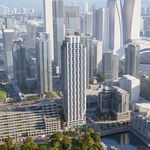I wasn't aware that anything else still existed in Ontario! Doesn't look as though they've done any passenger equipment since the 1950s though.
NSC has turned out to the one of the largest freight car manufacturers, but yes, the last passenger cars they made were in 1959.
Where were the Bombardier MR-90s EMU that are used on the AMT Deux-Montagnes line made?
La Pocatière, QC. South shore, a bit east of Montréal.
Hmm, and where do they manufacture the ICTS equipment (Vancouver Skytrain, etc.).
Millhaven, just west of Kingston. A lot of assembly was done at Vancouver for their respective orders, however.
I might have asked this before, but does the TTC get compensated for the fact that Bombarider has f'd this order up so royally?
I don't know how you could say that they've "...f'd this order...", but yes, the TTCs and Bombardier's lawyers are in regular contact about things like this.
There has been limited success IN THE PAST across Canada (and there better be success for the home province of BBD)! The MR-90 was just made for Montreal in the 90's....a whopping 58 were made.
Of course, the MR-90 was also the basis for the M-7, of which almost a thousand were made. So, they seem to have done okay with them.
The Bi-level coaches have 2 factories for North America, one in Thunder Bay and the other in Upper NY State.
Bombardier has a number of plants across North America, and they specialize on specific products and processes. La Pocatière, for instance, is their base of operations for sales in Quebec, and specializes in welding large stainless steel bodies. All of the bodies for the TRs, for instance, and built there. Thunder Bay does large aluminum structures, and assembles almost everything for Ontario. Most of the other plants - Plattsburg in New York, for instance - only do the final assembly to meet whatever the quotients are required for the sales to those states. They have no capability to produce the large structures necessary for things like car bodies.
They produce a similar model in Germany for the European market.
It may look similar but structurally (and developmentally) they are not even remotely close to being similar.
BBD has made about 1000 in Thunder Bay. The only other major (>100) purchase was for California. They are no lonter buying these cars and are switching over to a competitors product. So Thunder Bay is left with GO and a few smaller fleets.
Not quite. In the last 4 years, they've filled orders for Vancouver (WCE), Salt Lake City (Frontrunner) and Florida (Sun Rail), as well as the cars they've built for GO. That also ignores the fact that since the economic crash in 2008 there simply hasn't been as many commuter car orders for the whole industry as there had been prior to that. Look at all of the smaller commuter operations that have started up in the past 6 or 7 compared to those prior to that.
And yes, they lost the Los Angeles (Metrolink) order in 2006, sure, but that's why they've designed their own competing CEM product based on the BiLevel design.
The ICTS is a perfect example of why the government Ontario fails when creating home-grown tech. The province owned the technology and sold it for pennies to BBD. BBD made a few trains for Toronto, Vancouver and Detroit in Thunder Bay. But they now have the technology expertise in Montreal and factories making the next generation ICTS in far off cheaper places such as Gujarat India where they have produced almost 1000 cars.
While that's kind of the gist of what happened, it is also a hell of a lot more complicated than that. For instance, Bombardier purchased the transportation manufacturing assets from Lavalin - who in turn purchased UTDC from the Province in 1986 - in 1991, well after the systems in Detroit, Toronto and Vancouver had been up and running. The PUTRA LRT in Kuala Lumpur was the first system that Bombardier sold - in 1994.
And "...produced almost 1000 cars."? Last I checked, 600 is no where close to 1000.
So how much money over the years have we pumped into the Thunder Bay plant? And why is it there? It's there because it's where rail cars ended their journey 50 or 100 years ago when they delivered wheat to waiting Great Lake vessels. A factory needs to have a competitive cost adantage such as the material (steel in Hamilton), labour (India or Mexico), tech development expertise (Montreal in this case), close to the buyer (Toronto) or cheap hydro. The only cost advantage this plant has is subsidization by the Province of Ontario.
That is not even close to being close to the reality of the situation, in any respect. Look up the history of companies like Canadian Car & Foundry, Dofasco and A.V. Roe, and you'll begin to get an idea as to why it was located there.
By the by, you know why companies like Honda and Toyota regularly pass up opportunities to have new plants built for them in places like Tennessee? Yes, labour is cheaper there, but it's also of lower quality. In Ontario, the labour force is of a sufficiently high quality as to justify the additional costs of doing business up here.
Dan
Toronto, Ont.




